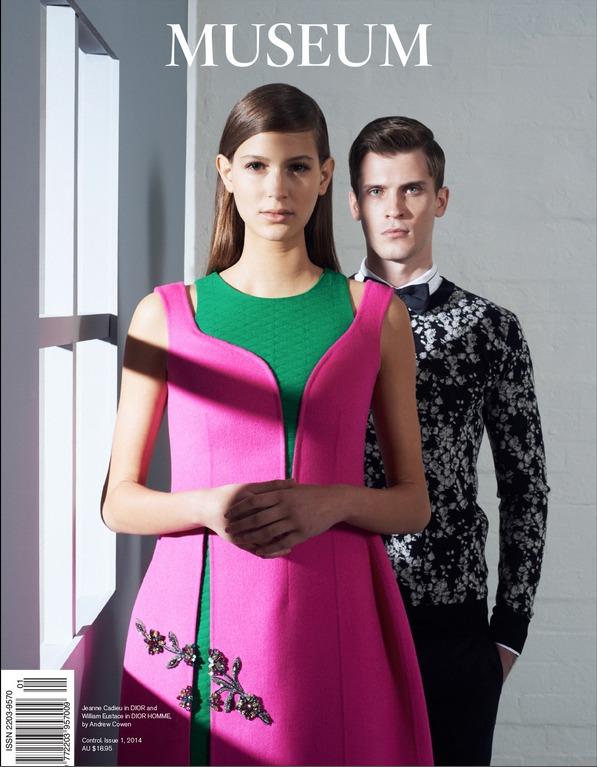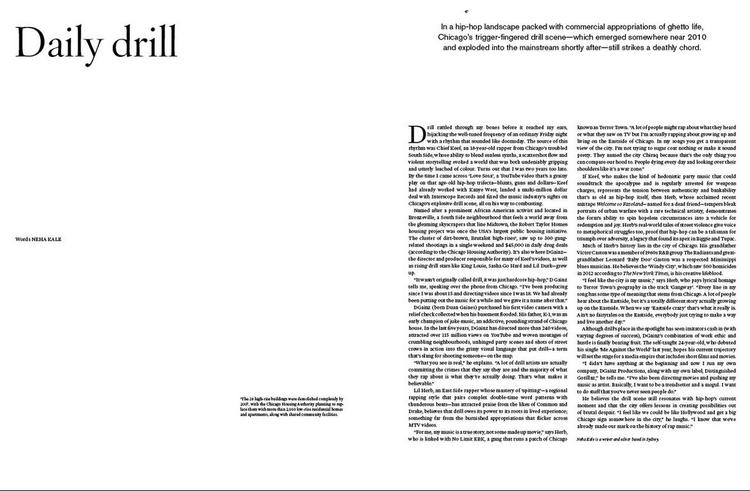First published in Museum magazine Issue 1 September 2014
In a hip-hop landscape packed with commercial appropriations of ghetto life, Chicago’s trigger-fingered drill scene – which emerged somewhere near 2010 and exploded into the mainstream shortly after – still strikes a deathly chord.
Drill rattled through my bones before it reached my ears, hijacking the well-tuned frequency of an ordinary Friday night with a rhythm that sounded like doomsday. The source of this rhythm was Chief Keef, an 18-year-old rapper from Chicago’s troubled South Side, whose ability to blend sunless synths, a scattershot flow and violent storytelling evoked a world that was both undeniably gripping and utterly leached of colour. Turns out that I was two years too late. By the time I came across ‘Love Sosa’, a YouTube video that’s a grainy play on that age-old hip-hop trifecta ⎯ blunts, guns and dollars ⎯ Keef had already worked with Kanye West, landed a deal with Interscope Records and fixed the music industry’s sights on Chicago’s explosive drill scene; all on his way to combusting.
Named after a prominent African American activist and located in Bronzeville, a South Side neighbourhood that feels a world away from the gleaming skyscrapers that line Midtown, the Robert Taylor Homes housing project was once the USA’s largest public housing initiative. The cluster of dirt-brown high-rises, which has seen up to 300 gang-related shootings in a single weekend and $45,000 in daily drug deals (according to the Chicago Housing Authority), is also where DGainz ⎯ the director and producer responsible for many of Keef’s videos, as well as rising drill stars like King Louie, Sasha Go Hard and Lil Durk ⎯ grew up.
“It wasn’t originally called drill, it was just hardcore hip-hop,” D Gainz tells me, speaking over the phone from Chicago. “I’ve been producing since I was about 15 and directing videos since I was 18. We had already been putting out the music for a while and we gave it a name after that.”
DGainz (born Duan Gaines) purchased his first video camera with a relief check collected when his basement flooded. His father, K-1, was a co-founder of juke music, an addictive strand of Chicago house. In the last five years, DGainz has directed more than 240 videos, attracted over 115 million views on YouTube and woven montages of crumbling neighbourhoods, unhinged party scenes and shots of street crews in action into the grimy visual language that put drill ⎯ a term that’s slang for shooting someone ⎯ on the map.
“What you see is real,” he explains. “A lot of drill artists are actually committing the crimes that they say they are and the majority of what they rap about is what they’re actually doing. That’s what makes it believable.”
But if you reduce drill to a social document, you also misunderstand its potential. The form, which sees deadpan recollections of murders, violence and life on the streets filtered through Autotune and laced with synthesizers and 808 kick-drums, uses nihilism as its narrative platform – a departure from rap’s obsession with hyperbole or the earnest moralising of conscious hip-hop.
Lil Herb, an East Side rapper whose mastery of “spitting” ⎯ a regional rapping style that pairs complex double-time word patterns with thunderous beats ⎯ has attracted praise from the likes of Common and Drake, believes that drill owes its power to its roots in lived experience; something far from the shiny appropriations that flicker across MTV videos.
“For me, my music is a true story, not some made up movie,” says Herb, who is linked with No Limit EBK, a gang that runs a patch of Chicago known as Terror Town. “A lot of people might rap about what they heard or what they saw on TV but I’m actually rappin’ about growin’ up and livin’ on the Eastside of Chicago. In my songs you get a transparent view of the city. I’m not tryin’ to sugar coat nothing or make it sound pretty. They named the city Chiraq because that’s the only thing you can compare our hood to. People dyin’ every day and lookin’ over they shoulders like it’s a war zone.”
If Keef, who makes the kind of hedonistic party music that could soundtrack the apocalypse and is regularly arrested for weapons charges, represents the tension between authenticity and bankability that’s as old as hip-hop itself, then Herb, whose acclaimed recent mixtape Welcome to Fazoland ⎯ named for a dead friend ⎯ tempers bleak portraits of urban warfare with a rare technical artistry, demonstrates the form’s ability to spin hopeless circumstances into a vehicle for redemption and joy. Herb’s real-world tales of street violence give voice to metaphorical struggles too, proof that hip-hop can be a talisman for triumph over adversity, a legacy that found its apex in Biggie and Tupac.
Much of Herb’s history lies in the city of Chicago. His grandfather Victor Gaston was a member of 1960s R&B group The Radiants and great-grandfather Leonard ‘Baby Doo’ Gaston was a respected Mississippi blues musician. He believes the windy city ⎯ which saw 500 homicides in 2012 according to The New York Times ⎯ is his creative lifeblood.
“I feel like the city is my music,” says Herb, who pays lyrical homage to Terror Town’s geography in the track ‘Gangway’. “Every line in my song has some type of meaning that stems from Chicago. A lot of people hear about the Eastside, but it’s a totally different story actually growin’ up on the Eastside. When we say ‘EastSide Crazy’ that’s what it really is. Aint no fairytales on the Eastside, everybody just tryin’ to make a way and live another day.”
Although drill’s place in the spotlight has seen imitators cash in (with varying degrees of success), DGainz’s combination of work ethic and hustle is finally bearing fruit. The self-taught 24-year-old, who debuted his single ‘Me Against the World’ last year, hopes his current trajectory will set the stage for a media empire that includes short films and movies.
“I didn’t have anything at the beginning and now I run my own company, DGainz Productions, along with my own label, Distinguished Gorillaz,” he tells me. “I’ve also been directing movies and pushing my music as artist. Basically, I want to be a trendsetter and a mogul. I want to do stuff that you’ve never seen people do.”
He also believes the drill scene encapsulates hip-hop’s current moment and that the city offers lessons in creating possibilities out of despair. “I feel like we could be like Hollywood and get a big Chicago sign somewhere in the city,” he laughs. “I know that we’ve already made our mark on the history of rap music.”

